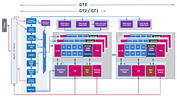Intel HD Graphics 500 vs Intel HD Graphics 510
Intel HD Graphics 500
► remove from comparison
The Intel HD Graphics 500 is an integrated processor graphics unit from the Apollo Lake generation (e. g. Celeron N3450 and Celeron N3350), which was announced mid 2016. The GPU can convince with low consumption figures, but the performance is only in the low-end segment and is rarely sufficient for modern games. Being a partial configuration of the Apollo Lake GPU, the HD Graphics 505 is equipped with just 12 Execution Units (EUs) (HD Graphics 505: 18 EUs) running at up to 650-700 MHz depending on the model. The technical specifications of the GPU are based on Intel's Gen9 architecture, which is also used for the more expensive Skylake series.
Due to its lack of dedicated graphics memory or eDRAM cache, the HD 505 has to access the main memory via processor (2x 64bit DDR3L-/LPDDR3-1866, LPDDR4-2400).
Performance
The HD Graphics 505 should be slightly slower than the older Broadwell GPU HD Graphics (Broadwell), so modern games (as of 2016) will rarely run smoothly even at the lowest settings.
Features
The revised video engine now decodes H.265/HEVC completely in hardware and thereby much more efficiently than before. Up to three displays can be connected via DP/eDP or HDMI (4K probably only at 30 Hz via HDMI 1.4).
Power Consumption
The TDP of the whole Pentium N4200 chip is 6 Watts by default, so the GPU is primarily used for (often passively cooled) netbooks or thin notebooks. The TDP can also be reduced to 4 Watts, but this will obviously affect the performance.
Intel HD Graphics 510
► remove from comparison
The Intel HD Graphics 510 (GT1) is an integrated graphics unit, which can be found in low-end ULV (Ultra Low Voltage) processors of the Skylake generation. This "GT1" version of the Skylake GPU offers 12 Execution Units (EUs) clocked at up to 950 MHz (depending on the CPU model). Due to its lack of dedicated graphics memory or eDRAM cache, the HD 510 has to access the main memory (2x 64bit DDR3L-1600 / DDR4-2133).
Performance
Depending on various factors like memory configuration, the HD Graphics 510 should perform sligthly below the older HD Graphics 4400 and will handle modern games (as of 2015) only in lowest settings (if it does at all).
Features
The revised video engine now decodes H.265/HEVC completely in hardware and thereby much more efficiently than before. Displays can be connected via DP 1.2 / eDP 1.3 (max. 3840 x 2160 @ 60 Hz), whereas HDMI is limited to the older version 1.4a (max. 3840 x 2160 @ 30 Hz). However, HDMI 2.0 can be added using a DisplayPort converter. Up to three displays can be controlled simultaneously.
Power Consumption
The HD Graphics 510 can be found in mobile processors specified at 15 W TDP and is therefore suited for compact laptops and ultrabooks.
| Intel HD Graphics 500 | Intel HD Graphics 510 | |||||||||||||||||||||||||||||||||||||||||||||||||||||||||||||||||||||||||||||||||||||
| Gen. 9 Series |
|
| ||||||||||||||||||||||||||||||||||||||||||||||||||||||||||||||||||||||||||||||||||||
| Codename | Apollo Lake | Skylake GT1 | ||||||||||||||||||||||||||||||||||||||||||||||||||||||||||||||||||||||||||||||||||||
| Architecture | Gen. 9 Apollo Lake | Gen. 9 Skylake | ||||||||||||||||||||||||||||||||||||||||||||||||||||||||||||||||||||||||||||||||||||
| Pipelines | 12 - unified | 12 - unified | ||||||||||||||||||||||||||||||||||||||||||||||||||||||||||||||||||||||||||||||||||||
| Core Speed | 300 - 700 (Boost) MHz | 300 - 950 (Boost) MHz | ||||||||||||||||||||||||||||||||||||||||||||||||||||||||||||||||||||||||||||||||||||
| Memory Bus Width | 64/128 Bit | 64/128 Bit | ||||||||||||||||||||||||||||||||||||||||||||||||||||||||||||||||||||||||||||||||||||
| Shared Memory | yes | yes | ||||||||||||||||||||||||||||||||||||||||||||||||||||||||||||||||||||||||||||||||||||
| API | DirectX 12_1, OpenGL 4.4 | DirectX 12_1, OpenGL 4.4 | ||||||||||||||||||||||||||||||||||||||||||||||||||||||||||||||||||||||||||||||||||||
| technology | 14 nm | 14 nm | ||||||||||||||||||||||||||||||||||||||||||||||||||||||||||||||||||||||||||||||||||||
| Features | QuickSync | QuickSync | ||||||||||||||||||||||||||||||||||||||||||||||||||||||||||||||||||||||||||||||||||||
| Date of Announcement | 01.09.2016 | 01.09.2015 | ||||||||||||||||||||||||||||||||||||||||||||||||||||||||||||||||||||||||||||||||||||
| Memory Type | DDR3/DDR4 |
|
| ||||||||||||||||||||||||||||||||||||||||
Benchmarks
3DM Vant. Perf. total + Intel HD Graphics 510
Cinebench R15 OpenGL 64 Bit + Intel HD Graphics 500
GFXBench T-Rex HD Offscreen C24Z16 + Intel HD Graphics 500
Average Benchmarks Intel HD Graphics 500 → 100% n=20
Average Benchmarks Intel HD Graphics 510 → 245% n=20
* Smaller numbers mean a higher performance
1 This benchmark is not used for the average calculation
Game Benchmarks
The following benchmarks stem from our benchmarks of review laptops. The performance depends on the used graphics memory, clock rate, processor, system settings, drivers, and operating systems. So the results don't have to be representative for all laptops with this GPU. For detailed information on the benchmark results, click on the fps number.

Hearthstone
2020
League of Legends
2019
The Crew 2
2018
X-Plane 11.11
2018
Team Fortress 2
2017
Rocket League
2017
Resident Evil 7
2017
Titanfall 2
2016
Farming Simulator 17
2016
Civilization 6
2016
The Division
2016
Rainbow Six Siege
2015
World of Warships
2015
Metal Gear Solid V
2015
Dota 2 Reborn
2015
Dirt Rally
2015
Battlefield Hardline
2015
F1 2014
2014
Sims 4
2014
Risen 3: Titan Lords
2014
GRID: Autosport
2014
Battlefield 4
2013
BioShock Infinite
2013
Tomb Raider
2013
Dead Space 3
2013
Counter-Strike: GO
2012
Diablo III
2012
Anno 2070
2011
StarCraft 2
2010Average Gaming Intel HD Graphics 500 → 100%
Average Gaming 30-70 fps → 100%
Average Gaming Intel HD Graphics 510 → 248%
Average Gaming 30-70 fps → 246%
For more games that might be playable and a list of all games and graphics cards visit our Gaming List


































